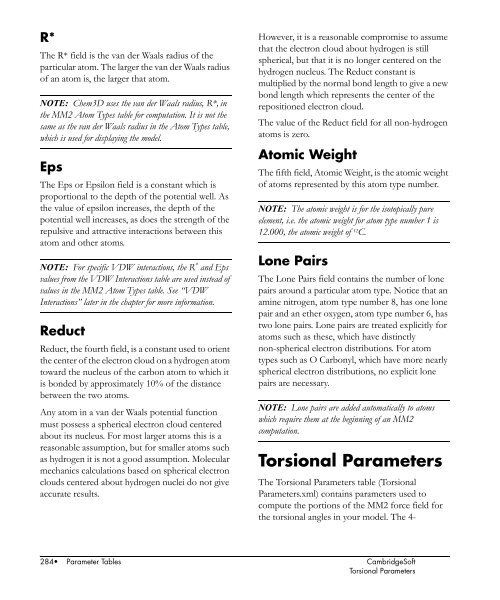Chem3D Users Manual - CambridgeSoft
Chem3D Users Manual - CambridgeSoft
Chem3D Users Manual - CambridgeSoft
Create successful ePaper yourself
Turn your PDF publications into a flip-book with our unique Google optimized e-Paper software.
Administrator<br />
R*<br />
The R* field is the van der Waals radius of the<br />
particular atom. The larger the van der Waals radius<br />
of an atom is, the larger that atom.<br />
NOTE: <strong>Chem3D</strong> uses the van der Waals radius, R*, in<br />
the MM2 Atom Types table for computation. It is not the<br />
same as the van der Waals radius in the Atom Types table,<br />
which is used for displaying the model.<br />
Eps<br />
The Eps or Epsilon field is a constant which is<br />
proportional to the depth of the potential well. As<br />
the value of epsilon increases, the depth of the<br />
potential well increases, as does the strength of the<br />
repulsive and attractive interactions between this<br />
atom and other atoms.<br />
NOTE: For specific VDW interactions, the R * and Eps<br />
values from the VDW Interactions table are used instead of<br />
values in the MM2 Atom Types table. See “VDW<br />
Interactions” later in the chapter for more information.<br />
Reduct<br />
Reduct, the fourth field, is a constant used to orient<br />
the center of the electron cloud on a hydrogen atom<br />
toward the nucleus of the carbon atom to which it<br />
is bonded by approximately 10% of the distance<br />
between the two atoms.<br />
Any atom in a van der Waals potential function<br />
must possess a spherical electron cloud centered<br />
about its nucleus. For most larger atoms this is a<br />
reasonable assumption, but for smaller atoms such<br />
as hydrogen it is not a good assumption. Molecular<br />
mechanics calculations based on spherical electron<br />
clouds centered about hydrogen nuclei do not give<br />
accurate results.<br />
However, it is a reasonable compromise to assume<br />
that the electron cloud about hydrogen is still<br />
spherical, but that it is no longer centered on the<br />
hydrogen nucleus. The Reduct constant is<br />
multiplied by the normal bond length to give a new<br />
bond length which represents the center of the<br />
repositioned electron cloud.<br />
The value of the Reduct field for all non-hydrogen<br />
atoms is zero.<br />
Atomic Weight<br />
The fifth field, Atomic Weight, is the atomic weight<br />
of atoms represented by this atom type number.<br />
NOTE: The atomic weight is for the isotopically pure<br />
element, i.e. the atomic weight for atom type number 1 is<br />
12.000, the atomic weight of 12 C.<br />
Lone Pairs<br />
The Lone Pairs field contains the number of lone<br />
pairs around a particular atom type. Notice that an<br />
amine nitrogen, atom type number 8, has one lone<br />
pair and an ether oxygen, atom type number 6, has<br />
two lone pairs. Lone pairs are treated explicitly for<br />
atoms such as these, which have distinctly<br />
non-spherical electron distributions. For atom<br />
types such as O Carbonyl, which have more nearly<br />
spherical electron distributions, no explicit lone<br />
pairs are necessary.<br />
NOTE: Lone pairs are added automatically to atoms<br />
which require them at the beginning of an MM2<br />
computation.<br />
Torsional Parameters<br />
The Torsional Parameters table (Torsional<br />
Parameters.xml) contains parameters used to<br />
compute the portions of the MM2 force field for<br />
the torsional angles in your model. The 4-<br />
284• Parameter Tables <strong>CambridgeSoft</strong><br />
Torsional Parameters











